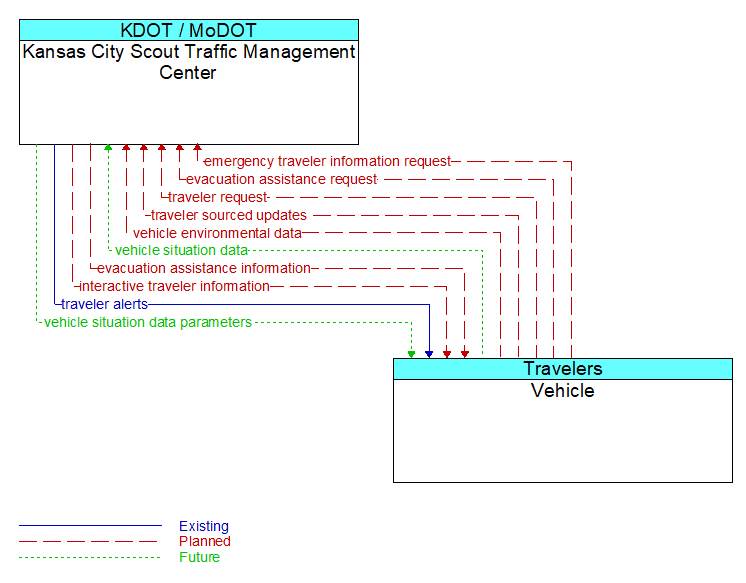Interface: Kansas City Scout Traffic Management Center - Vehicle

Architecture Flow Definitions
emergency traveler information request (Planned) Applicable ITS Standards
Request for alerts, evacuation information, and other emergency information provided to the traveling public.
evacuation assistance information (Planned) Applicable ITS Standards
Information on evacuation resources including self-evacuation options, anticipated pickup time and location if a transportation asset is to be deployed, destination shelter, and supporting information on what to bring, estimated reentry date/time.
evacuation assistance request (Planned) Applicable ITS Standards
A request for evacuation assistance, which may be registered in advance or issued during an evacuation. It specifies the location, number of people that need to be evacuated, and any special needs/requirements.
interactive traveler information (Planned) Applicable ITS Standards
Traveler information provided in response to a traveler request. The provided information includes traffic and road conditions, advisories, incidents, payment information, transit services, parking information, weather information, and other travel-related data updates and confirmations.
traveler alerts (Existing) Applicable ITS Standards
Traveler information alerts reporting congestion, incidents, adverse road or weather conditions, parking availability, transit service delays or interruptions, and other information that may impact the traveler. Relevant alerts are provided based on traveler-supplied profile information including trip characteristics and preferences.
traveler request (Planned) Applicable ITS Standards
A request for traveler information including traffic, transit, toll, parking, road weather conditions, event, and passenger rail information. The request identifies the type of information, the area of interest, parameters that are used to prioritize or filter the returned information, and sorting preferences.
traveler sourced updates (Planned) Applicable ITS Standards
Traveler posts on traffic and road conditions, transit services, traveler services, shelter information and other real-time crowd-sourced data that may be shared with other travelers.
vehicle environmental data (Planned) Applicable ITS Standards
Data from vehicle safety and convenience systems that can be used to estimate environmental and infrastructure conditions, including measured air temperature, exterior light status, wiper status, sun sensor status, rain sensor status, traction control status, anti-lock brake status, vertical acceleration and other collected vehicle system status and sensor information. The collected data is reported along with the location, heading, and time that the data was collected. Both current data and snapshots of recent events (e.g., traction control or anti-lock brake system activations) may be reported.
vehicle situation data (Future) Applicable ITS Standards
This flow represents vehicle snapshots that may be provided by the vehicle to support traffic and environmental conditions monitoring. Snapshots are collected by the vehicle for specific events (e.g., when a sensor exceeds a threshold) or periodically and reported based on control parameters when communications is available. Traffic-related data includes snapshots of measured speed and heading and events including starts and stops, speed changes, and other vehicle control events. Environmental data may include measured air temperature, exterior light status, wiper status, sun sensor status, rain sensor status, traction control status, anti-lock brake status, and other collected vehicle system status and sensor information. The collected data is reported along with the location, heading, and time that the data was collected.
vehicle situation data parameters (Future) Applicable ITS Standards
A request for vehicle situation data that includes parameters used to control the data that is reported and the flow of data reported by the vehicle. This flow identifies the type of data/snapshots that are requested and reporting parameters such as snapshot frequency, filtering criteria (data thresholds for reporting), and reporting interval.